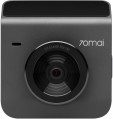External camera
One or more remote cameras in the standard equipment of the registrar, used for video recording of the traffic situation behind the car. In the vast majority of cases, the remote camera is attached to the DVR in
one copy. It covers the rear "stern" of the car and is simultaneously used as an assistant when reversing parking — the picture from the camera can be displayed on the DVR screen in real time. There can be
several remote cameras, which provides a wider coverage of the DVR's field of view.
Video resolution
The maximum video resolution supported by the optional DVR camera. Depending on the design and configuration, we can talk about both a remote camera and a camera for filming the interior (see above for both); this nuance should be clarified separately.
The higher the resolution, the more detailed the image from the camera will be, the more small details will be normally visible on it. On the other hand, high detailing affects the volume of materials to be filmed and the requirements for the “hardware” of the registrar (and, accordingly, affects the cost).
In general, additional cameras of modern recorders can be divided into the following categories:
— SD. "Standard" resolution (as opposed to HD — "high resolution"). A rather modest frame size, which at the same time allows you to significantly save memory for video recording and is suitable even for low-cost recorders. Specific resolution options include, but are not limited to, 628x582, 640x480, and 720x480.
— HD 720p. The traditional, most popular resolution for this video recording standard is 1280x720. In addition to it, registrars also found 960x720 (aspect ratio 4:3) and reduced in height 1280x480. HD is the most modest of today's high-definition standards, but still provides pretty decent detail.
— Full HD 1080p. The "classic of the genre" for this standard is the resolution of 1920x1080, however, there are other values in registrars, including very speci...fic ones — such as 1440x1080 (4:3 aspect ratio) and 1920x540 (halved vertical resolution). This is a fairly solid indicator even for the main camera of the registrar, and there is no need to talk about additional ones.
— Super HD. Not a particularly popular standard in video technology, which, nevertheless, has found application in video recorders. Most often provides a resolution of 2304x1296, which provides even more
Frame frequency
Maximum video frame rate supported by the optional DVR camera. Depending on the design and configuration, we can talk about both a remote camera and a camera for filming the interior (see above for both); this nuance should be clarified separately. Anyway, it is with this frequency that the shooting is carried out by default.
The higher the frame rate, the clearer the moving objects will be on the video, the less they will be blurred and the less “jerky” the video itself will be. It is believed that the most comfortable for the human eye is a speed of 24 to 60 frames per second; a lower frequency is already perceived as a “slideshow”, and a higher one only increases the amount of material being shot, without giving a visible increase in quality. At the same time, registrar cameras can also provide higher filming speeds than 60 fps — this provides good visibility of individual moving parts in slow motion or frame-by-frame playback.
Viewing angle
Viewing angle of the additional dashcam camera. Depending on the design and configuration, it may refer to either an external camera or an interior camera (see above for both); this nuance should be clarified separately. The viewing angle can be specified both horizontally and diagonally, which is why models with the same figures in the specifications may slightly differ in their actual field of view. However, in this case, this difference is not critical.
In theory, a wider viewing angle allows for capturing a larger area, but individual details in the frame become smaller. Additionally, wide-angle lenses can cause geometric distortions at the edges of the image; the DEWARP technology (see "Features") used to eliminate them is usually not used in additional cameras.

